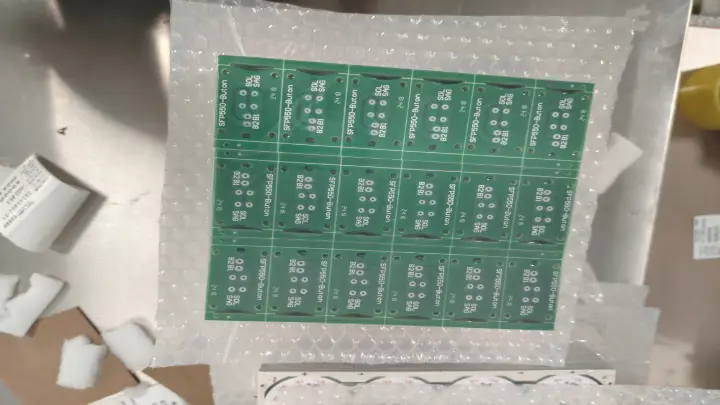Unveiling the Power of FR4 PCB Material: A Comprehensive Guide to Superior Circuit Performance

FR4 PCB material, known for its excellent electrical and mechanical properties, is extensively used in a wide range of applications across various industries. FR4 printed circuit board (PCB) material is the backbone of many electronic devices. In this article, we will delve into the world of FR4 PCB manufacturing and explore the key players in this industry. We’ll also discuss the importance of FR4 material, its manufacturing process, properties, and its diverse applications.
Definition of FR4 PCB material
Composition of FR4 material
FR4, short for Flame Retardant 4, which signifies its fire-resistant properties. It is a type of composite material composed of layers of fiberglass cloth and epoxy resin. These materials are pressed together under high heat and pressure to create a strong, durable, and flame-resistant substrate for electronic circuits. It is a composite material commonly used in the production of printed circuit boards (PCBs). It consists of a fiberglass substrate impregnated with epoxy resin, offering excellent electrical insulation and mechanical stability.
Historical Evolution of FR4 PCB Material
Early developments: The history of FR4 dates back to the 1950s when it was introduced as a superior replacement for other PCB materials. This marked the beginning of its widespread use in the electronics industry.
Milestones in FR4 material history: Significant milestones include the development of improved epoxy formulations, fiberglass weaves, and flame-retardant additives, which enhanced FR4’s electrical and thermal performance.
Influence on the electronics industry: FR4 has had a profound impact on the electronics industry’s growth, enabling the miniaturization of electronic components and the creation of increasingly complex devices.
Understanding FR4 Manufacturing Processes
Overview of the manufacturing process: The production of FR4 involves several key steps. It starts with the impregnation of fiberglass cloth with epoxy resin, followed by curing and lamination processes that create the final material.
Materials used in production: High-quality fiberglass cloth and epoxy resins are paramount in ensuring the reliability of FR4. The choice of these materials directly affects the material’s performance and characteristics.
Quality control and standards: Strict quality control protocols are essential to maintain consistency in FR4 production. Compliance with industry standards, such as IPC-4101 and UL 94V-0, is crucial to guarantee the reliability and safety of FR4 PCBs.
Key Properties of FR4 PCB Material
Electrical Insulation: One of the primary functions of FR4 is to provide excellent electrical insulation. The fiberglass-reinforced epoxy is an excellent insulator, preventing unwanted electrical conductivity between different components and traces on the PCB.
Mechanical Stability: FR4 material is known for its mechanical stability and rigidity. It can withstand the physical stresses and strains associated with handling, assembly, and use in electronic devices.
Thermal Resistance: FR4 exhibits remarkable thermal resistance, making it suitable for applications where PCBs may be exposed to high temperatures. This property is crucial in preventing the deformation or failure of PCBs due to excessive heat.
Flame Resistance: FR4 material is inherently flame-retardant. It does not readily catch fire or propagate flames, which is a critical safety feature, especially in electronic devices that may generate heat during operation.
The role of FR4 in emerging technologies: In the context of emerging technologies, FR4 continues to play a pivotal role. For instance, in the rollout of 5G technology, FR4-based PCB design manufacturing are crucial for the transmission of high-frequency signals. Explore how FR4 contributes to emerging tech such as Internet of Things (IoT), artificial intelligence, and electric vehicles.
Anticipated advancements in the coming years: With increasing demand for high-performance electronics, the industry is expected to push the boundaries of FR4 material. Discuss future advancements, such as improved thermal management, lower dielectric loss, and enhanced compatibility with lead-free soldering.
Market projections and opportunities: Provide insights into the growth prospects of the FR4 industry. Discuss market trends, the potential for diversification into new industries, and the opportunities for manufacturers in an ever-evolving electronics landscape.
Leading Manufacturers of FR4 PCB Material
Isola Group
Isola Group is a global leader in the production of advanced PCB materials. The company was founded in 1912 and has a long history of innovation in the materials industry. Isola is known for its commitment to quality and reliability, making it a preferred choice for many PCB manufacturers worldwide.
Isola has been at the forefront of FR4 material advancements. They have developed high-performance laminates and prepregs that offer improved electrical properties, thermal stability, and reduced signal loss. These innovations contribute to the enhancement of FR4 material, making it suitable for high-frequency and high-speed applications.
Nanya Technology Corporation
Nanya Technology Corporation is a major player in the semiconductor and PCB materials industry. Headquartered in Taiwan, Nanya has a strong global presence and is recognized for its high-quality FR4 materials. The company’s commitment to research and development has solidified its position in the industry.
Nanya’s contributions to FR4 technology include the development of advanced resin systems for FR4 laminates. These systems offer enhanced thermal stability, making FR4 material more reliable in high-temperature applications. Nanya’s research also focuses on reducing the environmental impact of PCB materials, aligning with growing sustainability concerns.
ITEQ Corporation
ITEQ Corporation, headquartered in Taiwan, is a leading global manufacturer of high-performance laminates and prepregs for PCBs. With a history spanning decades, ITEQ has established a reputation for delivering consistent, high-quality FR4 materials to the electronics industry.
ITEQ’s contributions to FR4 technology have centered on improving the material’s thermal performance. They have introduced laminates with enhanced thermal conductivity, enabling more efficient heat dissipation. This is particularly valuable in modern electronics where heat management is crucial for performance and longevity.
Shengyi Technology Co., Ltd.
Shengyi Technology is a well-known manufacturer of PCB materials with a strong presence in the global electronics market. The company’s commitment to technological innovation and quality control has made it a trusted supplier of FR4 materials to PCB manufacturers worldwide.
Shengyi Technology has made notable contributions to FR4 technology by developing advanced flame-retardant FR4 materials. These materials are designed to meet stringent safety standards while maintaining excellent electrical and mechanical properties. Shengyi’s innovations ensure that FR4 material remains at the forefront of safety and reliability in electronics.
Kingboard Laminates Holdings Ltd
Kingboard Laminates, headquartered in Hong Kong, is a key player in the PCB material industry. The company’s focus on innovation and sustainability has led to its prominence in the market.
Kingboard Laminates has been dedicated to enhancing the environmental performance of FR4 materials. They have worked on developing eco-friendly variants of FR4 that reduce the environmental impact of PCB manufacturing. Their contributions align with the industry’s in, their competitive price win the favor of more customers for the save of PCB mafacturing cost.
Selecting the Right FR4 PCB Mterial Manufacturer
Selecting the right manufacturer depends on factors such as material quality, cost, lead times, and the ability to meet specific technical requirements. Factors like proximity to the manufacturer can also be crucial for just-in-time production.
Real-world experiences shared by customers can provide valuable insights into a manufacturer’s reliability and customer service. Positive reviews can serve as an indicator of a manufacturer’s trustworthiness.
Analyzing case studies of successful collaborations between electronics companies and FR4 manufacturers helps readers understand the practical benefits of choosing the right manufacturer. These case studies illustrate how a strong partnership can lead to efficient, high-quality production.
Factors to Consider When Choosing an FR4 PCB Manufacturer
Selecting the right FR4 PCB manufacturer is a crucial decision for any project. Printed Circuit Boards (PCBs) are the foundation of electronic devices, and the manufacturer you choose can significantly impact the quality, cost, and overall success of your project. To help guide your decision-making process, here are critical factors to consider when selecting an FR4 PCB manufacturer:
PCB Quality Control
Ensure the manufacturer uses high-quality FR4 material, as this will affect the PCB’s performance, durability, and reliability. Evaluate the manufacturer’s production methods, including etching, drilling, and plating, to ensure they meet industry standards and best practices.
PCB Experience and Expertise
Choose a manufacturer with a proven track record in producing FR4 PCBs for your industry or application. Assess their technical capabilities and proficiency in designing, prototyping, and assembling PCBs.
PCB Certifications and Compliance
Verify that the manufacturer adheres to ISO quality management standards, such as ISO 9001 and ISO 14001. Ensure they comply with Restriction of Hazardous Substances (RoHS) directives if your project requires it.
PCB Cost and Pricing
Request detailed quotes and understand the cost breakdown, including tooling, setup fees, and shipping. Request detailed quotes and understand the cost breakdown, including tooling, setup fees, and shipping.
PCB Lead Time
Consider the manufacturer’s lead time for both prototypes and bulk orders. A shorter lead time can be crucial for time-sensitive projects.
PCB Prototyping and Testing
Look for a manufacturer that offers prototyping services to validate your designs before full-scale production. Inquire about their quality control and testing processes to ensure consistent, error-free PCBs.
PCB Customization and Capabilities
Confirm that the manufacturer can produce the specific type of FR4 PCBs your project requires (e.g., single-sided, double-sided, multi-layer, rigid, or flexible). If your project needs special features like controlled impedance, blind vias, or buried vias, make sure the manufacturer can accommodate these.
PCB Customer Support and Communication
Evaluate their communication and response times to address your inquiries or concerns. Ensure they offer technical assistance during the design and manufacturing stages.
PCB Support and Warranty
Research the manufacturer’s reputation by reading customer reviews and testimonials.
PCB Supply Chain and Electronic Component Sourcing
Ask about their supply chain management and component sourcing practices to ensure a reliable source of components.
Intellectual Property (IP) Protection
Discuss IP protection measures to safeguard your designs and sensitive information during the manufacturing process.
PCB Location and Shipping
Consider the manufacturer’s location, as it can impact shipping costs and delivery times, especially for just-in-time manufacturing.
PCB Reputation and References
Research the manufacturer’s reputation by reading customer reviews and testimonials. Request references or case studies related to projects similar to yours
Challenges in FR4 PCB Manufacturing
As electronic devices become smaller and more complex, PCBs must accommodate densely packed components. This requires precise manufacturing techniques and specialized equipment. In RF and microwave applications, impedance control, and signal integrity become critical. Manufacturing PCBs with controlled impedance requires precision in both material selection and manufacturing processes.
Designing and manufacturing multilayer FR4 PCBs requires tight registration control to ensure that inner layers align correctly, and the finished product has the desired electrical characteristics. As PCB design evolves, there is a need for advanced materials to meet the demands of high-speed and high-frequency applications. Developing, testing, and implementing these materials can be costly and time-consuming
Applications of FR4 PCBs
FR4 (Flame Resistant 4) PCBs, made from a type of glass-reinforced epoxy laminate, are among the most commonly used printed circuit board materials due to their versatility and reliability. They find extensive use in a wide range of applications across various industries and devices. Here, we’ll explore and explain the diverse range of applications where FR4 PCBs are preferred:
- Consumer Electronics
- Computing and Networking
- Computing and Networking
- Industrial Applications
- Industrial Applications
- Aerospace and Defense
- Telecommunications
- Renewable Energy
- LED Lighting
- Consumer Appliances
- Robotics
Want to discover more innovation electronic for business? check this article about PCB application in detail.
Conclusion
In conclusion, FR4 PCB material is the unsung hero of the electronics industry. Its fire-resistant properties, exceptional electrical insulation, and thermal stability make it an indispensable material for modern electronics. With a rich history and a promising future, FR4 PCBs continue to shape the world of technology.
Discover FINEST Group, your one-stop for PCBs, SMT, and components. Since 2003, we’ve excelled in PCB solutions. FINEST PCB Assemble Ltd was born for rapid PCB assembly and small batches. We provide components and full BOM support. Our advanced SMT factory in Shenzhen focuses on R&D and fast assembly. For top-quality PCB and assembly, choose FINEST Group. Send us your inquiries and let’s make electronics happen.



